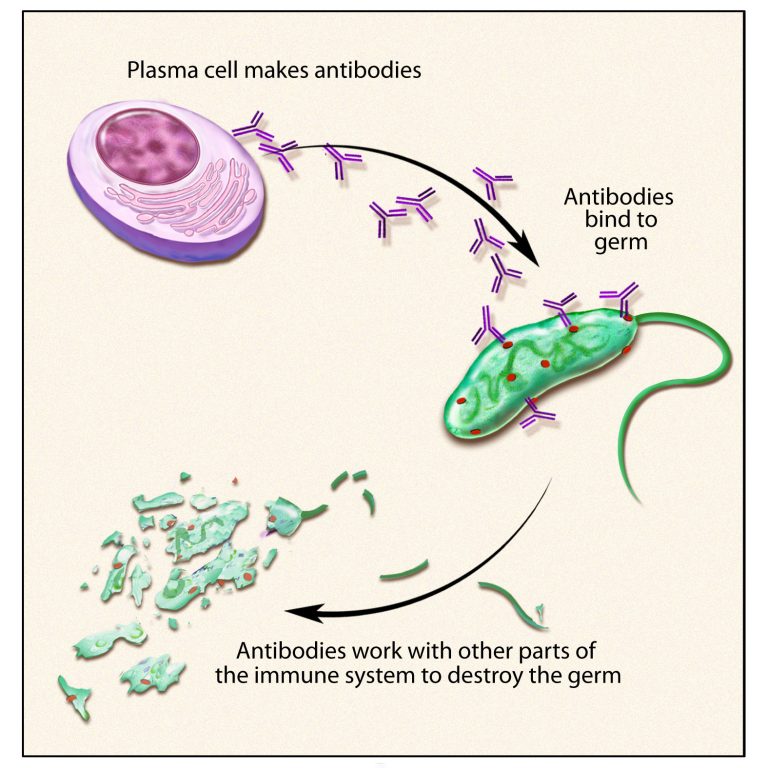As a board-certified veterinary internal medicine and emergency/critical care specialist, I’m used to seeing unwell patients. The sickest of the sick. But this week I saw cancer patient after cancer patient. Beautiful pets with committed families. I’m not a cancer specialist, and unfortunately the closest one in three hours away. So, I do my best to guide and educate pet parents about the best treatment for their fur babies. I’ve previously shared materials about various cancers, including lymphoma and hemangiosarcoma. This week I wanted to devote some time to dispersing helpful information about another cancer – multiple myeloma. I hope you enjoy it and find it shareworthy! Happy reading!
Multiple Myeloma – What is it?
Multiple myeloma is a cancer of specialized cells in the body called plasma cells. Plasma cells are also called plasma B cells, plasmacytes, and effector B cells. The main function of plasma cells is to secrete large volumes of antibodies that help to neutralize pathogens (e.g.: bacteria, viruses, parasites) in the body. Under normal circumstances, B cells originate in the bone marrow. After leaving the bone marrow, they encounter foreign substances in blood (called antigens) and subsequently interact with other cells of the immune system called T cells. When T cells and B cells interact, the former activate the latter. Activated B cells ultimately differentiate into plasma cells to produce antibodies. Multiple myeloma is a cancer that develops when plasma cells undergo malignant transformation.
Multiple myeloma currently accounts for less than eight percent of all blood-derived tumors in dogs. This cancer is even less common in cats. There is no breed or sex predilection. Multiple myeloma is usually diagnosed in older animals, typically between 8-9 years of age in dogs and 12-14 years of age in cats. To date, veterinarians do not know what causes plasma cells to turn into cancerous ones. Genetics may play a role in the development of multiple myeloma. Furthermore, plasma cell diseases have been associated with:
- Chronic exposure to antigens
- Petroleum products
- Working the agricultural industry
- Altered gene expression (e.g. c-myc oncogene in people)
- Altered protein expression (e.g.: cyclin D in dogs and people)
Multiple Myeloma – What does it look like?
Cancerous plasma cells secrete a large volume of a special protein called paraprotein or monoclonal (M) protein. Paraprotein may exist as a whole protein or in its components called heavy and light chains. The clinical signs seen in multiple myeloma patients are the result of either the paraprotein or expansion of malignant plasma cells in the bone marrow. Common issues encountered in multiple myeloma patients include:
- Bone destruction (called osteolysis) – Affected patients are often painful, resent walking, and/or have an obvious lameness. With progression, bone destruction can lead to pathologic fractures of affected bones.
- Thick blood (called hyperviscosity syndrome) – Due to elevated levels of paraprotein, blood becomes thick or viscous. Many patients subsequently develop neurologic signs (e.g.: seizures, dementia), visual impairments due to retinal damage, and heart muscle disease because the heart must work much harder to circulate the thicker blood.
- Bleeding tendency (called hemorrhagic diathesis) – Paraprotein coats clot-forming cells called platelets, preventing them from developing a normal blood clot. Paraprotein also interferes with various clotting proteins in the body. Clinical signs associated with hemorrhagic diathesis include bloody noses (called epistaxis), gingival bleeding, blood in urine and/or feces, and eyeball hemorrhage.
- Low blood cell counts (called cytopenias) – When plasma cells abnormally proliferate in the bone marrow, they disrupt the production and maturation of other cells made in the bone marrow, including platelets, red blood cells, and other white blood cells.
- Elevated blood calcium (called hypercalcemia) – Patients with multiple myeloma develop high blood calcium through various mechanisms, including bone destruction, secreting of a parathyroid hormone-related peptide, and binding of calcium to paraprotein.
- Kidney dysfunction – Approximately one third of dogs and cats with multiple myeloma develop kidney dysfunction due to high blood calcium, excess light chain production, and reduced blood flow caused by hyperviscosity.
Multiple Myeloma – How is it diagnosed?
Diagnoses of multiple myeloma in dogs and cats requires satisfaction of two of the criteria listed below:
- Radiographic evidence of bone destruction
- Documentation of light chain component of paraprotein in urine (called Bence Jones proteins)
- Identification of more than 10-20% plasma cells in bone marrow
- Documentation of excess paraprotein in the blood (called a monoclonal gammopathy)
- Identification of plasma cell infiltration in other organs (e.g.: spleen, liver) – cats only

To reach a definitive diagnosis based on the above-listed criteria, veterinarians will recommend specific blood, urine, bone marrow, and diagnostic imaging tests. Pet parents will likely find it quite helpful to consult with a board-certified veterinary internal medicine or cancer specialist to develop a logical and cost-effective diagnostic plan.
Multiple Myeloma – How is it treated?
Patients with multiple myeloma benefit from chemotherapy. Currently, the recommended treatment involves the use of two drugs – melphalan and prednisone. The overall response rate to treatment with these two drugs is ~92%, and the median survival time is 540 days.
Other drugs that have been used in dogs, cats, and/or humans to treat multiple myeloma patients are chlorambucil, lomustine (CCNU) cyclophosphamide, thalidomide, doxorubicin, vincristine, bortezomib, and toceranib phosphate Factors associated with a worse prognosis are high blood calcium, bone destruction, and finding Bence Jones proteins in urine. I’ve previously reviewed chemotherapy side effects, and you may find this information here. I strongly encourage pet parents to partner with a board-certified veterinary cancer or internal medicine specialist to discuss the best treatment for their fur babies.
Patients with multiple myeloma often benefit from other supportive interventions including fluid therapy, antibiotic therapy, and anti-pain therapies. Ensuring patients are as comfortable as possible is profoundly important. Many drugs and interventions are available to ensure patient comfort, including:
- Narcotics (e.g.: codeine, tramadol)
- Gabapentin
- Grapiprant
- Bisphosphonates
- Radiation therapy
- Orthotic devices (e.g.: splints & braces)
- Acupuncture
The take-away message about multiple myeloma in dogs and cats…
Multiple myeloma is a cancer of plasma cells that derive in the bone marrow. Clinical signs include orthopedic pain, visual impairment, bleeding disorders, and kidney dysfunction. Specific criteria must be satisfied to reach a definitive diagnosis. Treatment with chemotherapy is often highly rewarding.
To find a board-certified veterinary cancer specialist, please visit the American College of Veterinary Internal Medicine.
Wishing you wet-nosed kisses,
CriticalCareDVM







